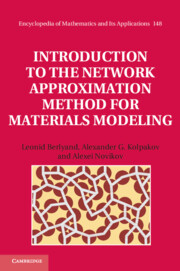Book contents
- Frontmatter
- Contents
- Preface
- 1 Review of mathematical notions used in the analysis of transport problems in densely-packed composite materials
- 2 Background and motivation for the introduction of network models
- 3 Network approximation for boundary-value problems with discontinuous coefficients and a finite number of inclusions
- 4 Numerics for percolation and polydispersity via network models
- 5 The network approximation theorem for an infinite number of bodies
- 6 Network method for nonlinear composites
- 7 Network approximation for potentials of bodies
- 8 Application of the method of complex variables
- References
- Index
4 - Numerics for percolation and polydispersity via network models
Published online by Cambridge University Press: 05 February 2013
- Frontmatter
- Contents
- Preface
- 1 Review of mathematical notions used in the analysis of transport problems in densely-packed composite materials
- 2 Background and motivation for the introduction of network models
- 3 Network approximation for boundary-value problems with discontinuous coefficients and a finite number of inclusions
- 4 Numerics for percolation and polydispersity via network models
- 5 The network approximation theorem for an infinite number of bodies
- 6 Network method for nonlinear composites
- 7 Network approximation for potentials of bodies
- 8 Application of the method of complex variables
- References
- Index
Summary
In this section, we present an application of the network model developed in Chapter 3 to the numerical analysis of high-contrast composite materials.
In Chapter 3, we expressed the leading term A of the conductivity of high-contrast composite materials through the solution of the network problem (3.4.11). The dimension of the network problem (3.4.11) is significantly smaller than the dimension of a non-structural (for example, finite elements or finite differences) approximation of the original problem (3.2.3)–(3.2.7). We demonstrate that the network approximation also provides us with an effective tool for the numerical analysis of high-contrast composite materials.
We consider models of a composite material filled with mono- and polydispersed particles (once again, we will model particles by disks). A composite material is called monodispersed if all disks have the same radii. If the radii of the disks vary, then the composite material is called polydispersed.
Computation of flux between two closely spaced disks of different radii using the Keller method
In order to analyze polydispersed composite materials, we need to know the flux between two disks (from one disk to another) of different radii if the potential on each disk is constant. A simple approximate formula for this flux was obtained in Keller (1987) for identical disks. We employ Keller's method to derive an approximate formula for the flux between two disks (the i-th and the j-th) of arbitrary radii Ri and Rj placed at a distance δij from one another (see Figure 4.1).
- Type
- Chapter
- Information
- Publisher: Cambridge University PressPrint publication year: 2012



